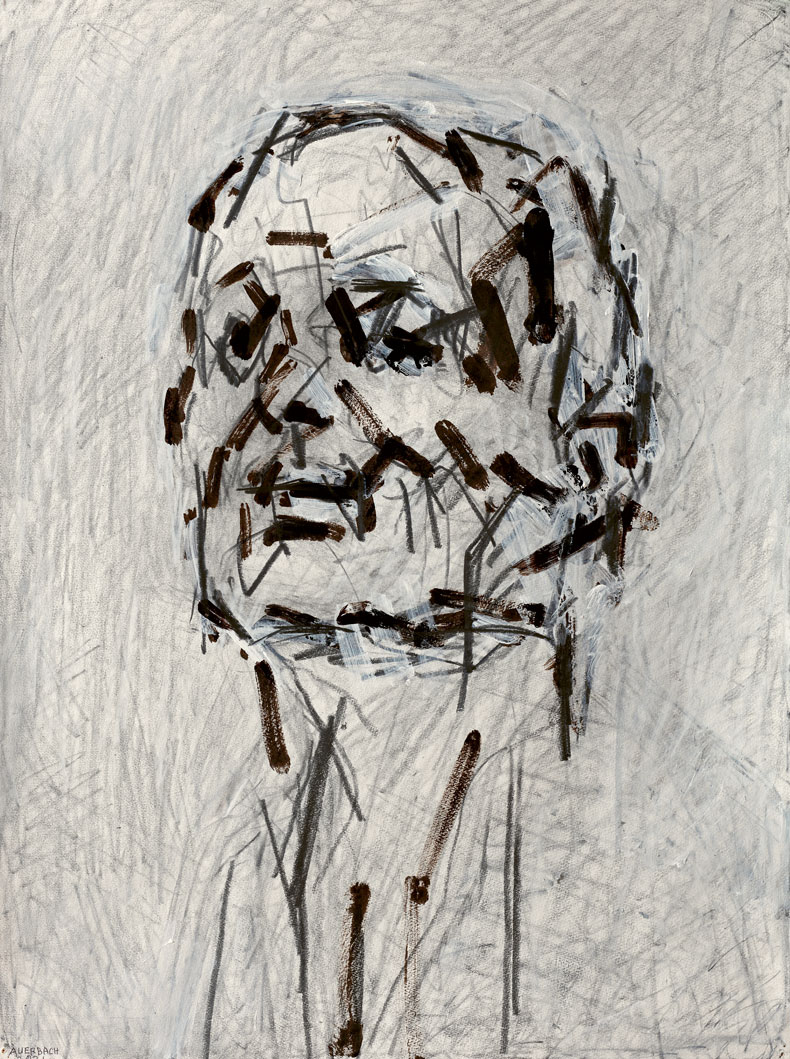As Gertrude Stein said more than once, ‘There is no such thing as repetition.’ Her justification was simple enough. It is, on one side, a kind of fundamental law of language and action. Repeat yourself, however so carefully, and the words, the story, the gesture morph in some small way with each recurrence. There is always what Stein called a new ‘insistence’, and every shifting insistence undoes the idea of repetition. But there is also more to it than this. Our inability to repeat is bound up, for Stein, with the essence of what it is to be alive. Insistence, she drops in, is ‘the Will to Live.’
It is a grandiose statement, to be sure – and quite the way for Stein to justify her own repetitious methods – but it feels true nevertheless. And perhaps never so visibly true as in the remarkable set of self-portraits by Frank Auerbach currently on show at Hazlitt Holland-Hibbert in London. Insistence has always made good sense of Auerbach, in terms of both method and results. Instantly recognisable, his work has long been an exercise in a kind of single-minded restlessness. It is visible across his career in his territorial circling of a tiny group of sitters, in his signature emphatic impasto, and the sudden blunt marks that sit among its billows like breakwaters. It seems, though, to have reached a kind of acme here, with Auerbach, 91 years old, opting at last to turn his gaze on himself, and avowing his intention to keep a brush in his hand until his last breath. As he said of himself and his friend Michael Roemer in a recent interview, ‘I wish for both of us that we fall over while we work.’
Self Portrait IX (2020), Frank Auerbach. Photo: © the artist; courtesy Frankie Rossi Art Projects

At first pass, the 20 portraits gathered here are striking for their uniformity. Split between vivid acrylic paintings and monochrome drawings intermittently heightened with touches of ink and paint, the first impression they give is of almost manic sameness. It is not just the same face that repeats but its pose, expression, angle of approach. Each presents the same three-quarter profile, bounded by cheek bone on one side, ear on the other. Whether he looks right or left, Auerbach adopts the same slight tilt of the chin, the same sloping glance downwards to the viewer, the same emphasis of jaw and neck. It does not stop at the pose. Same, too, are the Auerbachian pictorial gestures that bring each face into being. The drawings coalesce out of swift light scribbles of graphite in such a way that they seem, at times to be trembling incompletely towards focus at the front of the canvas. In some of them – Self Portrait IX (2020) – overpainting swoops in to still the shivers into solidity as if Auerbach has lost patience with what he has called his ‘old man’s marks’. The paintings have no such sense of hesitation. Despite the heavy layers and careful workings over in the coloured grounds, Auerbach’s head comes together bluntly in the acrylics almost as an abstract form: a face-glyph formed by a countable number of broad decisive strokes. If they are variations on a theme, they are variations bound by a private set of rules, strict and well-defined.
Self-Portrait IV (2021) Frank Auerbach. Photo: courtesy Frankie Rossi Art Projects; © the artist

And yet, the insistence changes. The saying beloved of motivational speakers and sports coaches is, ‘If you do what you’ve always done, you’ll get what you always got.’ It is not a saying you can imagine intruding for one second into Auerbach’s consciousness, but it is as if in his tenth decade, he is determined to prove it wrong. Each time he does what he has always done, something new emerges. In Self-Portrait IV (2021), the overlaid lines appear to nearly hover over the canvas like a mobile. Seen front-on they seem cursory, abstract, and somehow detached. Pass at an oblique angle they suddenly align, as if in mid-air, to form the clear sharp contours of Auerbach’s face. It is a remarkable effect. Elsewhere, a softening of the eye achieves the same trick – the old man’s marks settle into clarity precisely when the viewer’s focus falls off.
In the paintings, meanwhile, there is a kind of pigmentary psychology – which is the real glory of this show. Excessive scrutiny finds the face, and the soul behind it, caught in a state somewhere between dissolution and resolution – the direction of travel between the two is unclear. It is a balance contained not just in the overall assemblage of lines but in every stroke’s rich smear of particoloured, half-mixed paint. Stein’s ‘Will to Live’ asserts itself here above all. Not just in an artist determined to continue the work of looking and making, but in the materials of his pictures, which insist every time and inch by inch on the difference in their sameness. Here is hoping that Auerbach be able to keep insisting for a few years yet.
Self Portrait V (2022) Frank Auerbach, Photo: courtesy Frankie Rossi Art Projects; © the artist;

‘Frank Auerbach: Twenty Self-Portraits’, presented by Frankie Rossi Art Projects, is at Hazlitt Holland-Hibbert, London until 14 July.



